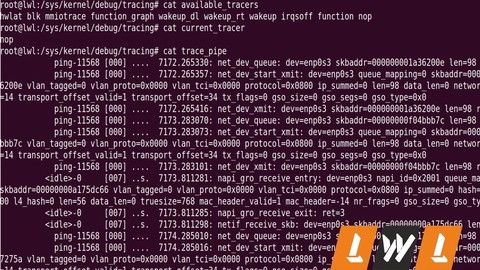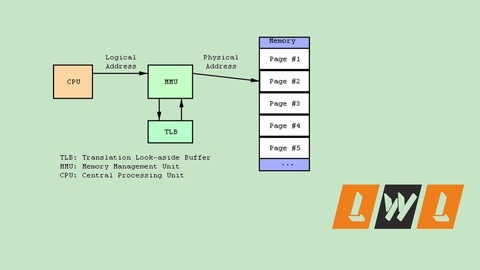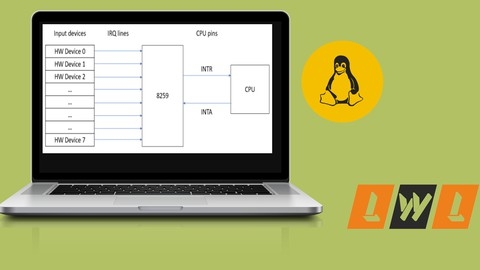The Linux kernel is the core of the Linux operating system, responsible for managing hardware resources, scheduling processes, and handling system calls.
Understanding kernel programming opens doors to building custom drivers, optimizing system performance, and developing unique operating system features.
By learning Linux kernel programming, you can gain a deep understanding of how the operating system works and become a more proficient system administrator or software developer.
Finding a good course on Linux kernel programming, especially on Udemy, can be challenging.
You’re looking for a course that’s comprehensive, practical, and taught by experts, but also caters to your learning style and interests.
We’ve reviewed numerous courses and recommend Linux Kernel Programming - IPC b/w Userspace and KernelSpace as the best course overall.
This course dives deep into the world of Linux kernel programming, specifically focusing on the powerful and versatile Netlink communication system.
You’ll learn about setting up your development environment, building kernel modules, and mastering the art of communication between user space and kernel space.
This hands-on approach with real-world examples makes it a great choice for both beginners and experienced learners.
While this is our top pick, there are other fantastic Linux kernel courses available on Udemy.
Keep reading to explore our recommendations for different learning styles and goals, from beginner-friendly introductions to advanced courses focused on specific kernel modules and system calls.
Linux Kernel Programming - IPC b/w Userspace and KernelSpace
This course dives deep into the world of Linux kernel programming, focusing on the powerful and versatile Netlink communication system.
You’ll start with the essentials, setting up your development environment and building your first “Hello World” kernel module (LKM).
This hands-on approach quickly establishes a foundation for understanding kernel programming basics.
But the real highlight is your exploration of Netlink sockets.
You’ll discover how these sockets act as a bridge between the user space (your applications) and the kernel space (the heart of your Linux system).
You’ll gain a thorough understanding of different communication mediums and how Netlink fits into the picture.
The course delves into the intricacies of Netlink message formats, teaching you about standard message types, flags, and the communication model.
You’ll then build a “Netlink Greet” example, writing code for both the kernel and user space.
This practical project will teach you how to send and receive messages between the two spaces, effectively showcasing the power of Netlink communication.
The course meticulously walks you through the code, explaining the workings of kernel socket buffers and even delving into the essential concept of TLV (Type-Length-Value) buffers.
This course will equip you with the skills and knowledge to confidently tackle complex kernel programming tasks.
Debugging Linux Kernel in Deep - Part 1
This course offers a comprehensive exploration of ftrace, a powerful tool for debugging and understanding the Linux kernel.
You’ll gain practical skills in tracing kernel functions, analyzing system behavior, and pinpointing the root of performance issues.
You’ll start by mastering the fundamentals of ftrace, learning how to enable it, explore its key features, and navigate the “tracefs” file system.
You’ll discover how to filter traces by function name, process ID, and even duration, allowing you to focus your analysis on specific areas of interest.
The course goes beyond basic ftrace usage, delving into the advanced world of tracepoints.
This powerful mechanism lets you trace specific kernel events, such as USB activity, network operations, and filesystem events.
You’ll gain insights into how these events trigger and understand the underlying code responsible.
To simplify the process of tracing and analysis, the course introduces the “trace-cmd” tool.
You’ll learn how to use this tool to start and stop tracing, filter results, generate reports, and even record and replay traces for detailed examination.
Through hands-on exercises and practical examples, you’ll put your knowledge into action, troubleshooting real-world kernel issues and gaining a deep understanding of how the Linux kernel operates.
Memory Management in Linux Kernel
This course offers a comprehensive dive into the intricacies of Linux memory management.
You’ll start with the fundamentals, gaining a clear understanding of physical and virtual address spaces and learning how to analyze memory maps using tools like /proc/iomem.
You’ll get hands-on with QEMU, experiencing firsthand how 32-bit Linux images allocate memory.
Moving beyond the basics, you’ll explore the core concepts of memory management: pages, page faults, and the critical struct page.
You’ll learn about memory zones – low and high memory – and discover how the buddy system allocator efficiently manages memory resources.
The course delves into practical memory allocation techniques with functions like kmalloc, kfree, and vmalloc.
You’ll learn to manipulate the GFP_FLAGS to control allocation behavior and gain a deep understanding of the differences and limitations of kmalloc versus vmalloc.
The curriculum extends to advanced topics, including kernel stacks and the check_stack.pl script for identifying potential stack overflows.
Synchronization in Linux Kernel Programming
This course is a deep dive into the world of Linux kernel programming, specifically focusing on the crucial area of concurrency.
You’ll learn to navigate the intricacies of managing concurrent operations within the kernel, starting with the fundamental concepts of concurrency and the challenges it presents.
Get ready to unravel the secrets of kernel preemption, a powerful technique that allows the kernel to efficiently switch between different processes.
You’ll also delve into the essential concept of reentrancy, ensuring your code remains reliable even when called multiple times within a single function.
Prepare to unravel the complexities of race conditions and critical regions, understanding their root causes and learning effective strategies to prevent them.
The course then guides you through the intricacies of various synchronization mechanisms.
You’ll explore per-CPU variables, designed to store data specific to each processor, and master the use of atomic operations, a critical tool for performing operations on memory locations without interruption.
You’ll then delve into the world of spin locks, a powerful tool for enforcing mutual exclusion between threads, and explore semaphores, which act as signaling mechanisms to coordinate access to shared resources.
The course goes further, examining mutexes, a more versatile synchronization mechanism than spin locks, and read-write locks, which enable efficient access to shared resources for both readers and writers.
You’ll also learn about sequence locks, a mechanism for synchronizing access to shared data structures, and RCU (Read-Copy-Update) locks, a powerful technique for lock-free data structures.
You’ll be equipped to write efficient and robust kernel code that handles concurrency gracefully, a valuable skill for any serious Linux kernel programmer.
Linux Kernel Development Course
You’ll begin by building a simple “Hello World” module, which serves as a hands-on introduction to the kernel’s structure and how to interact with it.
This initial module will introduce you to the necessary tools and coding techniques for kernel development.
Next, the course delves into the world of character devices, teaching you how to build your own from scratch.
Character devices are essential for interacting with hardware and peripherals, so mastering this aspect is crucial for anyone working with the Linux kernel.
Finally, the course covers the fundamental topic of file operations, exploring the intricate mechanisms behind how Linux manages data.
You’ll learn about files, inodes, and dentries, and understand how they work together to create a robust file system.
This knowledge forms a solid foundation for manipulating files within the kernel and even developing your own custom file systems.
Debugging Linux Kernel in Deep - Part 2
You’ll begin by understanding the hardware requirements and setting up your development environment.
The course then dives deep into KGDB functionality, guiding you through installing the kernel on your target machine, connecting to it using GDB, and mastering advanced techniques like disabling address randomization and setting breakpoints.
You’ll learn to leverage the TUI mode, setting breakpoints for specific operations like creating or deleting directories, and even pinpoint issues within specific lines of code.
The course explores real-world scenarios, like using a single serial port for both console and KGDB and debugging connection problems.
You’ll gain proficiency with valuable tools like agent-proxy and kgdbreboot, and delve into techniques like enabling pretty printing and debugging out-of-tree modules.
The course also teaches you how to utilize lx-symbols and lx_current for efficient debugging.
You’ll master the process of debugging init and exit sections of modules and tackle challenging scenarios like Out of Memory (OOM) conditions.
A dedicated section on Raspberry Pi3 provides a hands-on experience, guiding you through setting up the device, connecting it via GDB, and navigating source code.
Interrupts and Bottom Halves in Linux Kernel
This course takes you on a deep dive into the intricate world of Linux kernel interrupts and bottom halves.
You’ll gain a comprehensive understanding of how the Linux kernel manages interruptions from various devices, like your keyboard, mouse, and network card.
But it’s not just about the basics - you’ll delve into the fascinating concept of bottom halves, which are tasks processed after an interrupt is handled.
You’ll start with the fundamentals, understanding how interrupts are generated, how the hardware identifies them, and how the Linux kernel manages them.
You’ll explore important entities like the Programmable Interrupt Controller (PIC) and the Advanced Programmable Interrupt Controller (APIC).
You’ll also learn about different interrupt flags, including IRQF_ONESHOT, IRQF_NOBALANCING, and SMP IRQ Affinity.
This solid foundation will equip you to understand how the Linux kernel prioritizes and manages interrupts.
The course then dives into the different types of bottom halves, including softirqs, tasklets, and workqueues.
You’ll learn how to create and schedule them, exploring the advantages and disadvantages of each.
You’ll also dive into the concept of threaded IRQs, which allow interrupt handlers to be processed in a separate thread, preventing delays in the main interrupt handler.
You’ll gain insights into entities like ksoftirqd, responsible for executing pending softirqs, and how to use the cpumask to control processor affinity of workqueues.
You’ll learn how to use APIs like request_irq, disable_irq_nosync, tasklet_schedule, and queue_work to manipulate interrupts and bottom halves within your own Linux drivers.
This course goes beyond the basics, giving you the tools to design and implement efficient drivers that interact with the kernel’s interrupt handling mechanisms.
You’ll gain a deeper appreciation for the complexities of the Linux kernel and be able to analyze and troubleshoot interrupt-related issues in your applications.
Testing Linux Kernel
You’ll gain a solid understanding of the testing landscape, from basic usage tests to advanced frameworks like LTP, Kselftest, and LTP-DDT.
The course dives deep into the LTP (Linux Test Project) framework, explaining its design goals, test coverage, and practical application.
You’ll learn how to install and run LTP tests, interpret results using HTML reports, and even write your own test cases using the tst_res API and SAFE macros.
Beyond LTP, you’ll explore Kselftest, a testing framework specifically tailored to the Linux kernel.
You’ll gain insights into its purpose, different test types, and learn how to build and run Kselftest tests effectively.
The course also introduces you to LTP-DDT, a powerful tool for more detailed and comprehensive kernel testing.
You’ll learn about its enhancements over LTP, how to run tests using LTP-DDT, and even gain guidance on writing new test cases.
This course is ideal for anyone wanting to gain a thorough understanding of Linux kernel testing and develop the skills to contribute to the stability and reliability of the Linux ecosystem.
While the course covers a wide range of topics, it would benefit from more in-depth explanations of specific test cases, examples of practical applications, and perhaps a deeper dive into the nuances of each framework’s capabilities.








